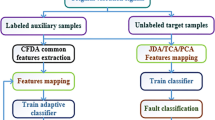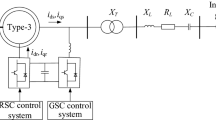Abstract
Accurate oscillation mode recognition and stability analysis based on big data are critical for the safe operation of wind turbine systems. This paper utilizes modern statistical and machine learning methodology to analyze the correlation between monitored wind turbine operation data and oscillation phenomena, and a system oscillation analysis and diagnosis method is proposed based on an improved association rule mining (ARM) model. Firstly, the oscillation modes in the power data are measured by the synchronous extraction transform. By improving the ARM model, a thorough study is conducted on the correlation between oscillation modes and variables such as wind speed, compensation degree, voltage fluctuation, etc. Finally, the component importance measure is used to optimize each element's risk weight calculation method relative to the system oscillation. The experiments demonstrate that the proposed association rule analysis method can effectively analyze the relationship between system oscillation phenomena and influencing factors and exhibits high diagnostic accuracy.







Similar content being viewed by others
References
Kamarposhti MA, Geraeli F (2019) Effect of wind penetration and transmission line development in order to reliability and economic cost on the transmission system connected to the wind power plant. Medbiotech J 3(2):35–40
Khan M, He C, Liu T et al (2021) A new hybrid approach of clustering based probabilistic decision tree to forecast wind power on large scales. J Electr Eng Technol 16:697–710
Zidane N, Belaid S-L (2022) A new fuzzy logic solution for energy management of hybrid photovoltaic/battery/hydrogen system. Revue Roumaine des Sciences Techniques-Serie Electrotechnique et Energetique 67(1):21–26
Dekali Z, Baghli L, Boumediene A (2021) Experimental implementation of the maximum power point tracking algorithm for a connected wind turbine emulator. Revue Roumaine des Sciences Techniques-Serie Electrotechnique et Energetique 66(2):111–117
**aorong X, Zhang Xu, Huakun L, Hui L, Yunhong Li, Chuanyu Z (2017) Characteristic analysis of subsynchronous resonance in practical wind FARMs connected to series-compensated transmissions. IEEE Trans Energy Convers 32(3):1117–1126
Kamarposhti MA, Alinezhad M (2011) Effects of STATCOM, TCSC, SSSC and UPFC on static voltage stability. Int Rev Electr Eng 93(1):33–42
Rad IS, Alinezhad M, Naghibi SE, Kamarposhti MA (2011) Detection of internal fault in differential transformer protection based on fuzzy method. Int J Phys Sci 6(26):6150–6158
Shokouhandeh H, Latif S, Irshad S, Ahmadi Kamarposhti M, Colak I, Eguchi K (2021) Optimal management of reactive power considering voltage and location of control devices using artificial bee algorithm. Appl Sci 12(1):27
Kamarposhti MA, Shokouhandeh H, Alipur M, Colak I, Zare H, Eguchi K (2022) Optimal designing of fuzzy-PID controller in the load-frequency control loop of hydro-thermal power system connected to wind farm by HVDC lines. IEEE Access 10:63812–63822
Yiwei Fu, Chen L, Zhe Yu et al (2020) Data-driven low frequency oscillation mode identification and preventive control strategy based on gradient descent. Electr Power Syst Res 189:106544
Zhao Y, Huo H, Xu HT (2020) Application of two-stage random forest classification method to low-frequency oscillation monitoring. J Northeast Electr Power Univ 40(2):60–67 (in Chinese)
Weike MO, Jiaqing LV, Pawlak M et al (2020) Power system oscillation mode prediction based on the Lasso method. IEEE Access 8:101068–101078
Wang Y, Xu Z, Zhou K et al (2021) On the correlation model between extreme disaster weather and distribution transformer fault types. IEEE 10th data driven control and learning systems conference (DDCLS). IEEE 2021:935–940
**nghua W, Zuming Y, Yongbin Z et al (2021) Research on correlation factor analysis and prediction method of overhead transmission line defect state based on association rule mining and RBF-SVM. Energy Rep 7(S1):359–368
Miao J, **e D, Gu C, Wang X, Zhang Y, Zhu M (2019) Correlation analysis between oscillation mode and impact factor of doubly-fed induction generator. Proc CSEE 39(17):5049–5060+5286
Mohamed A, Hui Li, Salah K, Ahmed K, Mahmoud ED, Mohammed K, Faiz SH (2021) A recent analytical approach for analysis of sub-synchronous resonance in doubly-fed induction generator-based wind Farm. IEEE Access 9:68888–68897
Young SJ, Ke Ma (2017) Wind energy systems. Proc IEEE 105(11):2116–2131
Yu GYuMXuC (2017) Synchroextracting transform. IEEE Trans Industr Electron 64(10):8042–8054
Daubechies I, Jianfeng Lu, Hau-Tieng Wu (2010) Synchrosqueezed wavelet transforms: an empirical mode decomposition-like tool. Appl Comput Harmon Anal 30(2):243–261
Agrawal R, Imieliński T, Swami A (1993) Mining association rules between sets of items in large databases. ACM SIGMOD Rec 22(2):207–216
Hipp J, Güntzer U, Nakhaeizadeh G (2000) Algorithms for association rule mining-a general survey and comparison. ACM 2(1):58–64
Zhang J, Sun H, Sun Z et al (2020) Reliability assessment of wind power converter considering SCADA multistate parameters prediction using FP-growth, WPT, K-means and LSTM network. IEEE Access 8:884455–884466
Acknowledgements
The work is supported by The science and technology innovation Program of Hunan Province (Grant No: 2021RC4061).
Author information
Authors and Affiliations
Corresponding author
Additional information
Publisher's Note
Springer Nature remains neutral with regard to jurisdictional claims in published maps and institutional affiliations.
Rights and permissions
Springer Nature or its licensor (e.g. a society or other partner) holds exclusive rights to this article under a publishing agreement with the author(s) or other rightsholder(s); author self-archiving of the accepted manuscript version of this article is solely governed by the terms of such publishing agreement and applicable law.
About this article
Cite this article
Li, Z., Wang, Y., **ao, H. et al. Association Analysis of Wind Turbine Grid-Connected Oscillation Modes and Influencing Factors Based on Improved Association Rule Mining. J. Electr. Eng. Technol. (2024). https://doi.org/10.1007/s42835-024-01956-y
Received:
Revised:
Accepted:
Published:
DOI: https://doi.org/10.1007/s42835-024-01956-y




